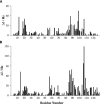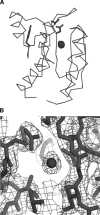Distinguishing multiple chemotaxis Y protein conformations with laser-polarized 129Xe NMR
- PMID: 15741343
- PMCID: PMC2253452
- DOI: 10.1110/ps.041231005
Distinguishing multiple chemotaxis Y protein conformations with laser-polarized 129Xe NMR
Abstract
The chemical shift of the (129)Xe NMR signal has been shown to be extremely sensitive to the local environment around the atom and has been used to follow processes such as ligand binding by bacterial periplasmic binding proteins. Here we show that the (129)Xe shift can sense more subtle changes: magnesium binding, BeF(3)(-) activation, and peptide binding by the Escherichia coli chemotaxis Y protein. (1)H-(15)N correlation spectroscopy and X-ray crystallography were used to identify two xenon-binding cavities in CheY that are primarily responsible for the shift changes. One site is near the active site, and the other is near the peptide binding site.
Figures





Comment in
-
Detection of multiple protein conformations by laser-polarized xenon.Protein Sci. 2005 Apr;14(4):847. doi: 10.1110/ps.051398705. Protein Sci. 2005. PMID: 15772304 Free PMC article. No abstract available.
References
-
- Bellsolell, L., Prieto, J., Serrano, L., and Coll, M. 1994. Mg2+ binding to the bacterial chemotaxis protein CheY results in large conformational changes involving its functional surface. J. Mol. Biol. 238 489–495. - PubMed
-
- Bolotovsky, R., Steller, I., and Rossman, M.G. 1998. The use of partial reflections for scaling and averaging X-ray area-detector data. J. Appl. Crystallogr. 31 708–717.
-
- Bren, A. and Eisenbach, M. 1998. The N terminus of the flagellar switch protein, FliM, is the binding domain for the chemotactic response regulator, CheY. J. Mol. Biol. 278 507–514. - PubMed
-
- Brünger, A.T., Adams, P.D., Clore, G.M., DeLano, W.L., Gros, P., Grosse-Kunstleve, R.W., Jiang, J.S., Kuszewski, J., Nilges, M., Pannu, N.S., et al. 1998. Crystallography & NMR system: A new software suite for macro-molecular structure determination. Acta Crystallogr. D Biol. Crystallogr. 54 905–921. - PubMed

